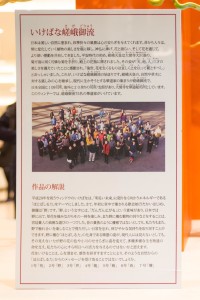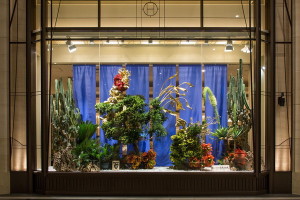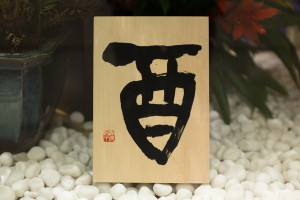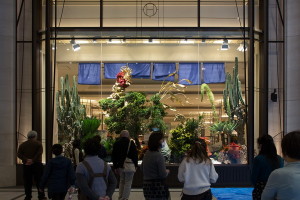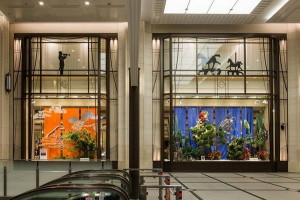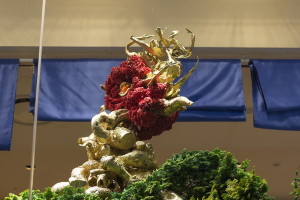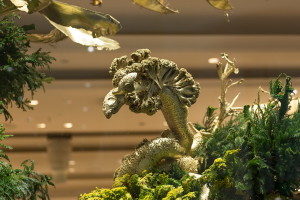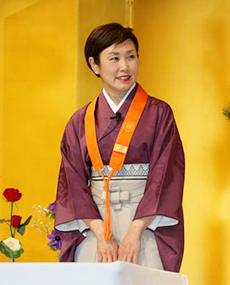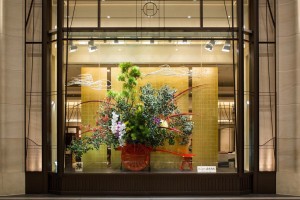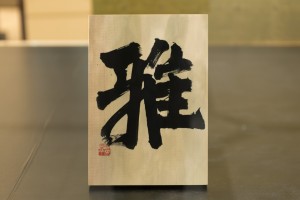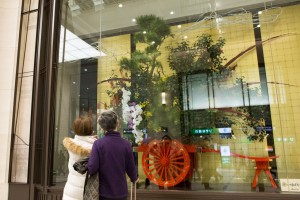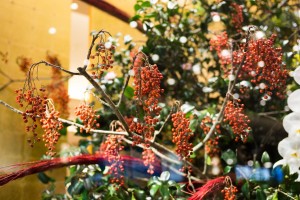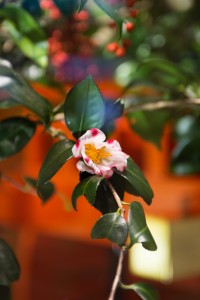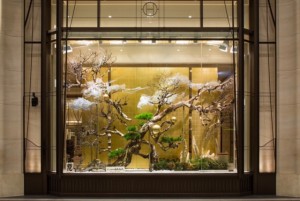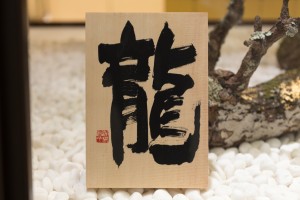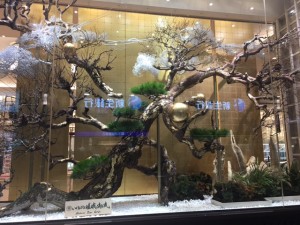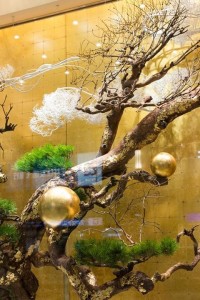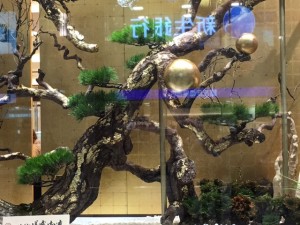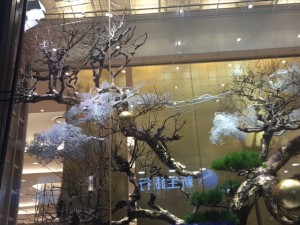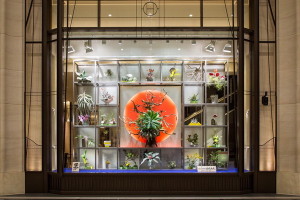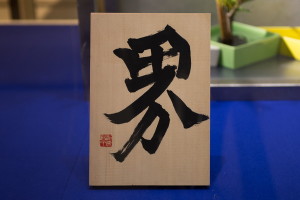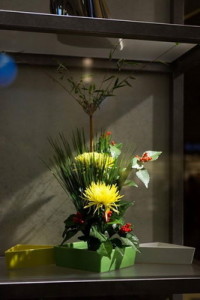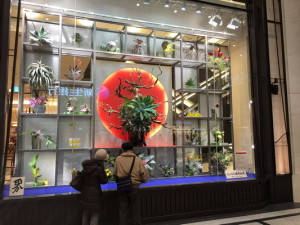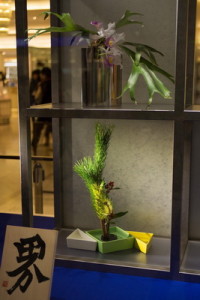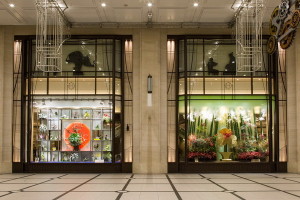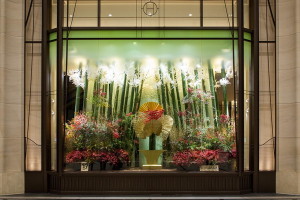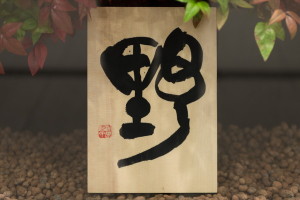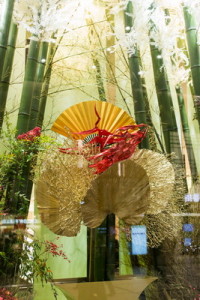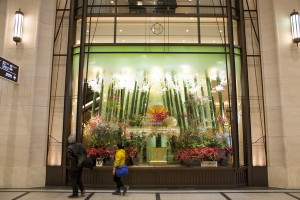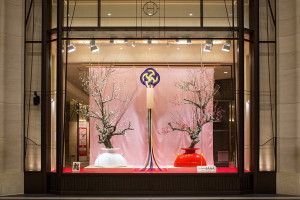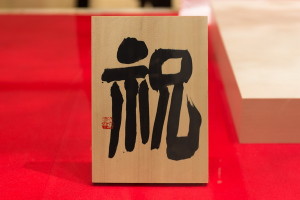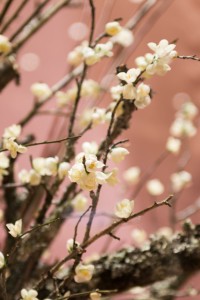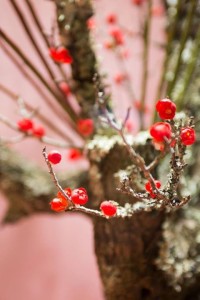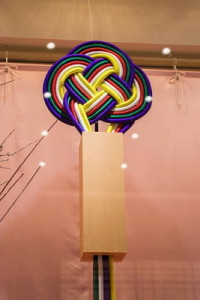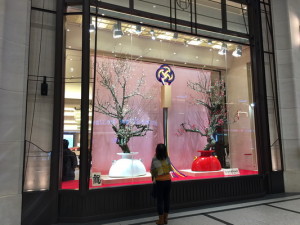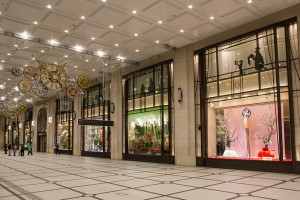2017年梅田阪急百貨店コンコースウィンドウに嵯峨御流が迎春花を挿花しました。2016年12月27日から2017年1月15日まで
7面の作品を一つずつご紹介します。嵯峨御流大阪地区の100人の先生方と一緒に作り上げたものです。写真は、阿部朋也さん。時々私のスナップ写真もまざっていますが。
各ウィンドウの高さは4m.幅は5mから7m。奥行わずか1.2mの範囲にいけています。
ウィンドウコンセプトは、私が考えたものですが、英訳は阪急さんが翻訳依頼して下さったものです。
「酉」
夜の“あけ”を告げる鶏は、太陽神を祭る伊勢神宮にも、神の動物として飼われている。酉年に因み、鶏冠杉や鶏頭を使って「鶏」を見立てた作品。伊藤若冲の「仙人掌群鶏図」から連想して、江戸時代に珍重された大サボテンを配し、ソテツなど南国の植物を使って、庭園に遊ぶ鶏の姿を描く。
花材:チャボヒバ・鶏頭・鶏冠杉・貝塚伊吹・ソテツ・ヤシ新芽(鶏の尾)・サボテン・エケべリア
Rooster
The rooster announces the break of day. The Grand Shrine of lse which enshrines the sun god also reveres the rooster as a sacred bird in tribute to the coming year -Year of the Rooster – this arrangement depicts a rooster with ‘Cristata’ Japanese cedar and Cockscomb. Using a giant cactus inspired by Ito Jakuchu’s Saboten Gunkei-zu (“Cactus and Domestic Fowl), the artwork depicts a rooster playing in a garden among sago palms and other tropical plants.
2017年梅田阪急百貨店コンコースウィンドウに嵯峨御流が迎春花を挿花しました。2016年12月27日から2017年1月15日まで
7面の作品を一つずつご紹介します。嵯峨御流大阪地区の100人の先生方と一緒に作り上げたものです。写真は、阿部朋也さん。時々私のスナップ写真もまざっていますが。
各ウィンドウの高さは4m.幅は5mから7m。奥行わずか1.2mの範囲にいけています。
ウィンドウコンセプトは、私が考えたものですが、英訳は阪急さんが翻訳依頼して下さったものです。
「雅」
平安時代、宮廷用の牛車を御所車といい、高位高官の乗り物であった。嵯峨天皇の曾孫が白川の里に別荘を構え、里に咲く色とりどりの花で飾った御所車を献じた故事から、屋形部分を取り去り勾欄で囲い、その中に器を置き花をいける設えを「御所車」と呼ぶ。
花材:蛇の目松・椿・葉牡丹・レッドウィロー・胡蝶蘭・オンシジウム・白着色垂れ桑
Sophisticated Grace
Higher officials in the Heian Era used an ox-drawn coach called Goshoguruma as a court carriage.This artwork is inspired by an elegant anecdote telling how a great-grandchild of Emperor Saga,who lived in another villa in Shirakawa Village, decorated a carriage with colorful flowers that bloomed in the village as a gift to the Emperor. This arrangement of placing a dish inside a carriage with its roof removed and surrounding the part with decorative railing is also called Goshoguruma.
2017年梅田阪急百貨店コンコースウィンドウに嵯峨御流が迎春花を挿花しました。2016年12月27日から2017年1月15日まで
7面の作品を一つずつご紹介します。嵯峨御流大阪地区の100人の先生方と一緒に作り上げたものです。写真は、阿部朋也さん。時々私のスナップ写真もまざっていますが。
各ウィンドウの高さは4m.幅は5mから7m。奥行わずか1.2mの範囲にいけています。
ウィンドウコンセプトは、私が考えたものですが、英訳は阪急さんが翻訳依頼して下さったものです。
「龍」
伐採される運命の松に出会い、この松の幹を龍の姿に見立てて、作品に昇華させたいと思った。龍は天空を切り開いて昇って行く「ほとばしる力」であるエネルギーの象徴。天上に大きくうねる雲は良き事を呼び寄せる、縁起の良い瑞雲とした。
花材:赤松の木・落羽松(ラクウショウ)気根・岩ヒバ・和ラン・白着色ツゲ・松かさ
Dragon
Coming upon this pine tree that was due to be cut down, the author saw a vision of a dragon in its trunk and brought it to life in a work of art. A torrent of energy surges from the rising dragon cutting through the roof of heaven. The billowing clouds in the heaven are the iridescent clouds Buddhists believe to bring good fortune.
2017年梅田阪急百貨店コンコースウィンドウに嵯峨御流が迎春花を挿花しました。2016年12月27日から2017年1月15日まで
7面の作品を一つずつご紹介します。嵯峨御流大阪地区の100人の先生方と一緒に作り上げたものです。写真は、阿部朋也さん。時々私のスナップ写真もまざっていますが。
各ウィンドウの高さは4m.幅は5mから7m。奥行わずか1.2mの範囲にいけています。
ウィンドウコンセプトは、私が考えたものですが、英訳は阪急さんが翻訳依頼して下さったものです。
「界」
花で曼荼羅をイメージした。中心の花は全てに平等に降り注ぐ太陽のエネルギーを表現している。どんなものにも命がありその命はすべてつながってこの世に存在している。しかもどこをとってもそこが中心となって繋がっていくものだという曼荼羅の思想は、人と人との関係においても通じる。人と人が手をつなぎ和の心で結びつく絆によって、未来は明るく広がる。
花材:アガベ・チランジア・古木・サボテン類・多肉植物・御所好「御題花器『野』」
World
This flower arrangement captures the image of a mandala. The center flower represents the sun, which showers energy equally on all living things.The mandala depicts how everything has life and how each individual life is its own center whilst also being connected to other lives as part of their existence in this world. The future opens up brightly through bonds among people created with wa no kokoro (“respect for others and harmony”).
2017年梅田阪急百貨店コンコースウィンドウに嵯峨御流が迎春花を挿花しました。2016年12月27日から2017年1月15日まで
梅田阪急百貨店コンコースウィンドウに2017年1月15日まで展示されている7面の作品を一つづつご紹介します。嵯峨御流大阪地区の、100人と一緒に作り上げたものです。写真は、阿部朋也さん。時々私のスナップ写真もまざっていますが。
「野」
天皇が催される、新年御歌会始め。平成29年の御題「野」に因んで、『野は嵯峨野さらなり』と清少納言が枕草子に詠まれた嵯峨野の風景を、大覚寺竹林の真竹(まだけ)を使って竹林と小径で表現している。1200年余り前の平安時代に、嵯峨御所を営まれた嵯峨天皇は、嵯峨野の地を愛し、みずから花をいけ、命の大切さと世界平和を願われた。竹の異名である「平安」に意を通わせ、嵯峨天皇の御心を、明るい未来の為に伝えていきたい。中央の花は「光輝く竹から生まれたかぐや姫」を見立てた。 花材:真竹・南天・おたふく南天・ヘリコニア・さつま杉・金着色海松・カニシダ
Field
This floral artwork derives its title from the theme of the New Year Imperial Poetry Event for 2017.It depicts a scene of Sagano, with a small lane through a bamboo grove, created using madake,carefully selected Japanese timber bamboo, from the grove in Daikakuji Temple. “Field” conveys Emperor Saga’s hope for peace in the world, the preciousness of life, and his love for the land of Sagano,which he displayed through his flower arrangements. The flower in the center represents Kaguya-hime,”Princess Kaguya” born from shining bamboo.
2017年梅田阪急百貨店コンコースウィンドウに嵯峨御流が迎春花を挿花しました。2016年12月27日から2017年1月15日まで
7面の作品を一つづつご紹介します。嵯峨御流大阪地区の100人の先生方と一緒に作り上げたものです。写真は、阿部朋也さん。時々私のスナップ写真もまざっていますが。
各ウィンドウの高さは4m.幅は5mから7m。奥行わずか1.2mの範囲にいけています。
ウィンドウコンセプトは、私が考えたものですが、英訳は阪急さんが翻訳依頼して下さったものです。
「祝」
平安時代、正月初の卯の日に飾られた、魔除けの「卯槌(うづち)」を中央に飾り、左右に紅白梅をいける。1年の吉運を招き、開運・出世・幸運を得る願いを作品に込めた。花材:紅白梅・卯槌c
Celebration
An amulet called “Uzuchi”(decorative hammer), which is said to have been displayed on the first “U noHi” (Day of the Rabbit)of the year, as long ago as the Heian Era. is in the center, with red and white plum blossoms to its right and left. This artwork represents hope for the coming of good fortune and a wish for a year full of happiness.
2017年梅田阪急百貨店コンコースウィンドウに嵯峨御流が迎春花を挿花しました。2016年12月27日から2017年1月15日まで
全体のコンセプト
